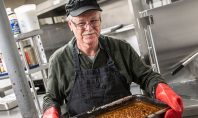Battle of the Bulge Association – Lehigh Valley Chapter
Compatriots, and even Allentown’s Lionel Adda, at times, were uncertain about sharing their experiences in World War II and in the Battle of the Bulge.
But since its first meeting in May 1998, then held in Walnutport, the Lehigh Valley chapter of the national organization first called Veterans of the Battle of the Bulge—since changed to the Battle of the Bulge Association—has reunited veterans to reflect on their service from Dec. 16, 1944 to Jan. 25, 1945 at the officially-titled Ardennes Counteroffensive, the last major German offensive campaign on the Western Front during World War II.
This month’s Dec. 17 chapter meeting at the Lehigh Valley Hotel & Conference Center in Bethlehem comes a day after the 75th anniversary of the start of the Battle of the Bulge. Veterans there will receive a special commemorative certificate.
Judy Greenhalgh, the chapter’s initial vice president and education committee founder, says camaraderie is what veterans find at meetings now presided over by Easton’s John Kuhn, but the mission became education—reaching out to what’s now 80,000 people in Lehigh Valley schools and community and church groups to teach “that freedom is not free.”
“I think it was a catharsis for (veterans),” says Greenhalgh, who grew up in Nazareth. “They would say, ‘I don’t think I can,’ then we’d ask a round of questions, and they’d take it from there. Then, they’d ask us, ‘When are we going out again?’”
At some school presentations, you can hear a pin drop, then see a tear in a child’s eye. “Some hug the vets,” she says.
Adda—now 97 years old—was deployed from the Army Specialized Training Program (his technical study in pre-engineering at Hendrix College in Arkansas), to the 99th infantry division, D company’s first battalion, 393rd regiment, a heavy machine gun squad. On the frontlines through 1944, into 1945 and the end of the war, he finished in the Office of Military Government in Berlin, helping prepare German officers for elections. When discharged, he graduated with a B.S., M.S., and eventually a Ph.D. in physics, all from Lehigh University, then spent the bulk of his career at Bell Laboratories.
Begun in the dark, “we were in danger from the beginning (at the Bulge),” says Adda, who counts 10-15 close calls on his life. “We all felt like something was brewing, but they didn’t tell us.”
Upon arrival, he asked his squadron leader what should concern him. That superior said it’d been quiet, so nothing. The next morning—his first on the battlefront—a bullet from a German sniper whizzed by his right ear. “After that, I got a little more careful,” he says.
But carefulness was allusive. Wet and cold, his camp once built a fire to warm up and dry clothes. Then, he began thinking, “What if the trickle of smoke is seen by the Germans?” Within five minutes, German gunfire struck a tree above, wounding two Americans. When Adda returned for his coat, it was in shreds from fire bursts that trickled down from German gunfire. “If I’d stayed there, I wouldn’t be here today,” he says. “I’m absolutely certain those shell bursts would’ve killed me.”
Peter Leslie Jr., the chapter’s first president, also helped start 10 additional chapters. Lehigh Valley has always been open-armed. Now, children carry on for fathers who served in the war. Greenhalgh’s and chapter secretary Meta Binder’s included.
For Greenhalgh, a retired German teacher from Palisades High School, her father’s twin brother, Henry Byrnes, perished while serving the Army’s 95th Infantry in the Battle of Metz on Nov. 15, 1944. Her father, John Byrnes, served the Marine Corps in the South Pacific. Her stepfather, Donald Heckman, served in the 702nd Tank Battalion, 3rd Army under Gen. George Patton.
Binder, a retired East Penn School District elementary teacher, doted on her father, James Binder, and his service as an Army medic in the 661st Tank Destroyer Battalion attached to the 69th Infantry. He was a chapter member until his passing four years ago at age 90. “My dad lived it but was never one to speak of it,” she says.
Chapter luncheons—the third Tuesday of each month—once attracted 70. Sometimes 100 attended the Christmas party, and once 120 came to a D-Day picnic. Of late, attrition dipped attendance to 42 in August, then 21 in September. “I think it’ll come back around,” says Binder, who organizes the event and its speakers.
Though not a chapter member, Allentown’s Clarence Smoyer, 96, the “Hero of Cologne,” received the U.S. Army’s Bronze Star in September at the National WWII Memorial in Washington, D.C. for his service as a Sherman Tank loader and gunner, which is detailed in the New York Times bestseller Spearhead: An American Gunner, His Enemy, and a Collision of Lives in World War II. He was the group’s October speaker.
Then and now, these heroes deserve praise for their service—and their courage to share their memories.
“I never forgot what happened, but I hadn’t talked about it,” Adda says. “Within the group, I thought maybe I should share what I did—and so I have.”













